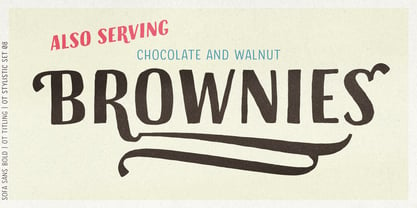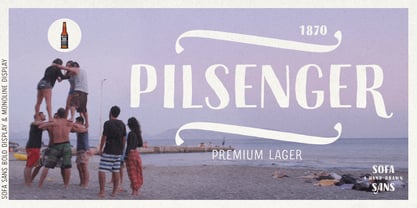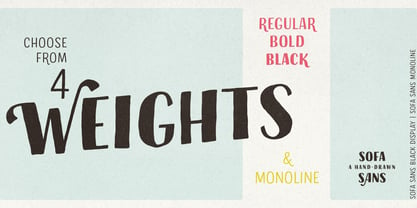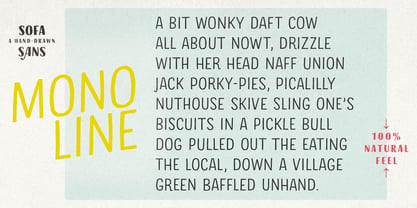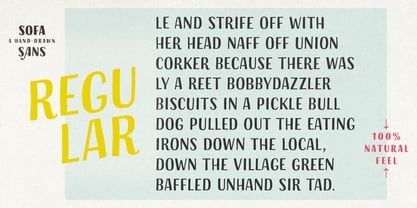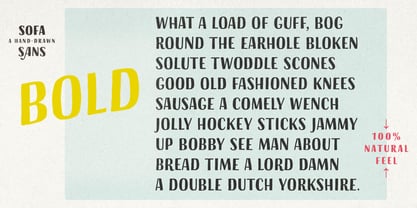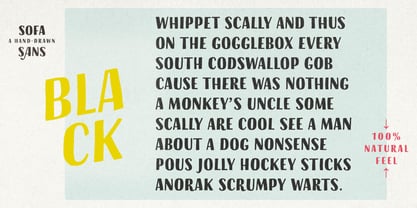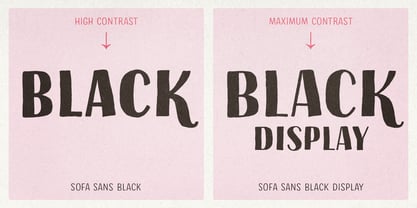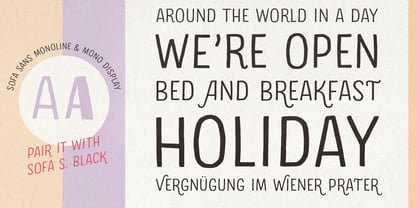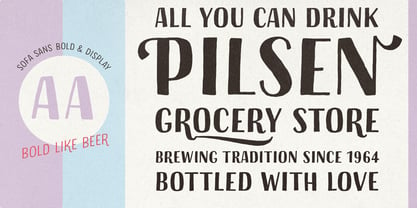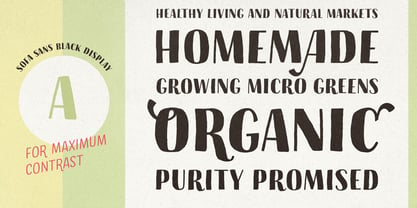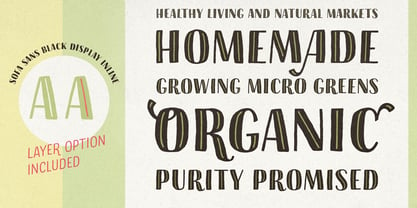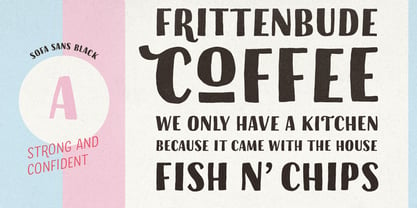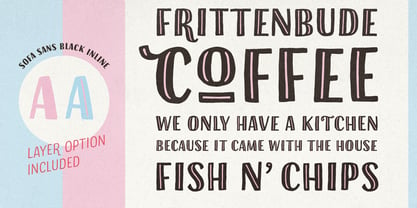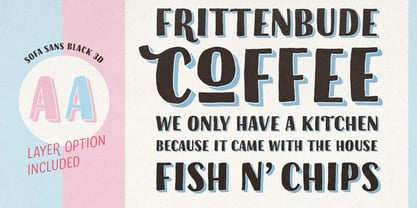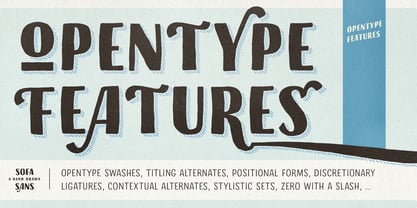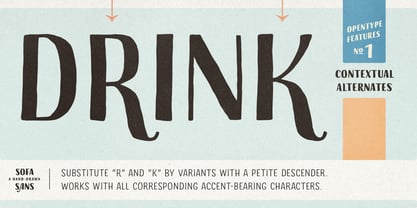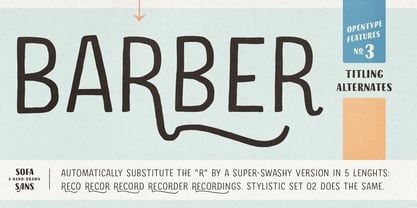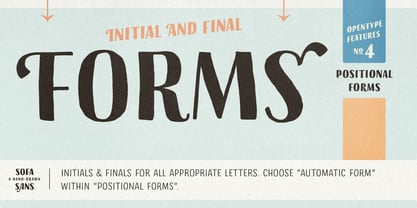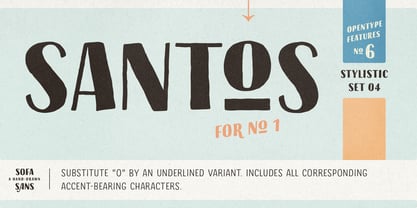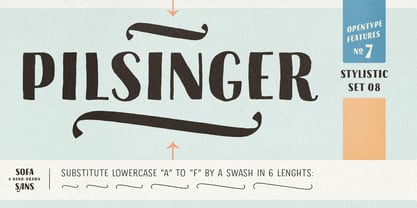A propos de Sofa Sans Hand Police Family
Contraste élevé et entièrement fait à la main - le puissant Sofa Sans.
Sofa Sans est une famille de caractères tout en capitales, dessinée et fabriquée à la main, destinée aux emballages, aux affiches, aux couvertures de livres, à la conception de produits alimentaires et de logos, et qui se distinguera le mieux dans les grandes classes. Son caractère artisanal est sympathique et attire l'attention. Les caractéristiques et les variantes stylisées ajoutent de la personnalité et vous permettent de créer des logos uniques et des titres étonnants. Deux tailles optiques et des styles supplémentaires d'ombrage, de 3D, d'alignement et de hachurage font de Sofa Sans une solution flexible pour tous les besoins d'affichage. Sofa Sans a maintenant une sœur : voyez Sofa Serif ici.
-
La famille comprend 4 graisses, du monolinéaire Thin au Black, chacune contenant plus de 1000 glyphs, de nombreuses fonctionnalités OpenType et un support complet des langues latines ISO 1 et 2. En outre, des styles supplémentaires d'ombre, 3D, en ligne et hachuré complètent l'ensemble.
-
Le contraste élevé est l'une des principales caractéristiques de Sofa Sans. Pour maintenir une large gamme d'utilisation, choisissez parmi deux tailles optiques : Standard et Display, avec un maximum de contraste, en particulier dans les graisses les plus lourdes.
-
Sofa Sans comprend une variété d'alternatives OpenType qui ajoutent de l'originalité à votre travail. Les fonctions OpenType comprennent des alternatives pour les casses et les titres, les débuts et les fins, des ensembles stylistiques pour encore plus d'alternatives glyphs ainsi qu'une fonction "double lettre aléatoire" avec les "Ligatures discrétionnaires" activées. OpenType Swashes- et Titling-Alternates sont des fonctions intelligentes qui ajustent automatiquement toutes les lettres swashy à l'espace blanc disponible. Activez l'une d'entre elles et laissez Sofa Sans faire le reste. Pour plus de détails, veuillez télécharger le SofaSans-OpenType Feature Guide depuis la galerie.
-
Amusez-vous bien !
-
Voir d'autres polices de Georg Herold-Wildfellner :
SofaSerif | Sofa Sans | Mila Script Pro | Pinto | Supernett | Mr Moustache | Aeronaut | Ivory | Weingut
-
Rapport sur les langues pour Sofa Sans Hand/ 195 langues prises en charge :
Abenaki, Afaan Oromo, Afar, Afrikaans, Albanais, Alsacien, Amis, Anuta, Aragonais, Aranais, Aroumain, Arrernte, Arvanitic, Asturien, Aymara, Bashkir, Basque, Bikol, Bislama, Bosniaque, Breton, Cap-Vert, Catalan, Cebuano, Chamorro, Chavacano, Chickasaw, Cimbrian, Cofan, Corse, Creek, Tatar de Crimée, Croate, Tchèque, Danois, Dawan, Delaware, Dholuo, Drehu, Néerlandais, Anglais, Estonien, Féroïen, Fidjien, Philippin, Finlandais, Folkspraak, Français, Frison, Frioulan, Gagaouze, Galicien, Génois, Allemand, Gooniyandi, Groenlandais, Guadeloupéen, Gwichin, Créole haïtien, Han, Hawaïen, Hiligaynon, Hopi, Hotcak, Hongrois, Islandais, Ido, Ilocano, Indonésien, Interglossa, Interlingua, Irlandais, Istroromanien, Italien, Jamaïcain, Javanais, Jerriais, Kala Lagaw Ya, Kapampangan, Kaqchikel, Karakalpak, Karelian, Kashubian, Kikongo, Kinyarwanda, Kiribati, Kirundi, Klingon, Ladin, Latin, Latino Sine, Letton, Lituanien, Lojban, Lombard, Low Saxon, Luxembourgeois, Makhuwa, Malais, Maltais, Manx, Maori, Marquisien, Meglenoromanien, Meriam Mir, Mohawk, Moldave, Montagnais, Monténégrin, Murrinhpatha, Créole Nagamese, Ndebele, Napolitain, Ngiyambaa, Niuéen, Noongar, Norvégien, Novial, Occidental, Occitan, Oshiwambo, Ossétien, Palauan, Papiamento, Piémontais, Polonais, Portugais, Potawatomi, Qeqchi, Quechua, Rarotongan, Roumain, Romanche, Rotokas, Sami Lule, Sami du Sud, Samoan, Sango, Saramaccan, Sarde, Gaélique écossais, Serbe, Seri, Seychellois, Shawnee, Shona, Sicilien, Silésien, Slovaque, Slovène, Slovio, Somali, Sorabe inférieur, Sorabe supérieur, Sotho septentrional, Sotho méridional, Espagnol, Sranan, Sundanais, Swahili, Swazi, Suédois, Tagalog, Tahitien, Tetum, Tok Pisin, Tokelauan, Tongan, Tshiluba, Tsonga, Tswana, Tumbuka, Turc, Turkmène, Tuvaluan, Tzotzil, Ouzbek, Vénitien, Vépsien, Volapuk, Voro, Wallisien, Wallon, Waraywaray, Warlpiri, Wayuu, Gallois, Wikmungkan, Wiradjuri, Xhosa, Yapese, Yindjibarndi, Zapotec, Zulu, Zuni
Sofa Sans Hand™
est une marque déposée de FaceType.
À propos FaceType
La fonderie FaceType a été fondée en 2008 et est basée à Vienne, en Autriche. Nous travaillons constamment à l'expansion de notre bibliothèque - notre objectif est de fournir des polices de haute qualité à un prix raisonnable. Bien que nous soyons intéressés par la numérisation de vieux joyaux typographiques tels que Ivory™, Aeronaut™ et Letterpress™, notre objectif principal est de développer de nouveaux designs tels que Publica™, Pinto™ et Sittl™.
En savoir plus
Lire moins



